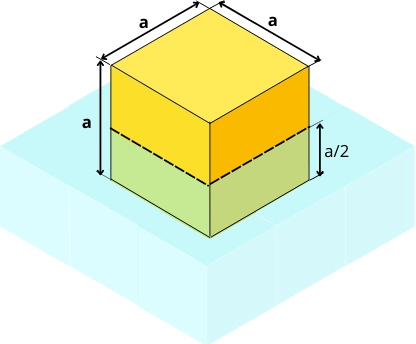One of the key points for the difference between the law of floatation and Archimedes’ principle is that the law of floatation is related to the weight of the liquid displaced by a floating body while Archimedes’ principle is related to the buoyant force exerted by the liquid on a partially or fully submerged body.
Let’s understand them before looking at the difference.
Law of floatation:
According to the law of floatation, a floating object displaces the amount of liquid that weighs equal to the weight of the object.
∴ Weight of liquid displaced by floating object = Weight of the object
Example:-

The above figure shows the object of weight ‘W’ floating in the liquid. In this case the weight of the liquid displaced by the floating object is given by,
`\mathbf{W_{\text{object}}}` = `\mathbf{W_{\text{liquid displaced}}}`
Archimedes’ principle:
Archimedes’ principle says that the upward force or buoyant force exerted by the liquid on a partially or fully submerged object is equal to the weight of the liquid displaced by the object.
Thus according to Archimedes’ law,
`\mathbf{F_{\text{Buoyant}}}` = Weight of liquid displaced
Example:-
The below figure shows a cube of side ‘a’ floating in liquid up to the depth of `\frac{a}{2}`.

The liquid displaced by an object is equal to the volume of the portion of the object immersed in liquid.
`V_{\text{displaced}}` = `V_{\text{Immersed}}`
Weight of liquid displaced is given by,
`W_{\text{liquid displaced}}` = `V_{\text{displaced}}` x `\rho_{\text{liquid}}`
According to Archimedes’ principle, the buoyant force acting on an object is given by,
`F_{\text{buoyant}}` = `W_{\text{liquid displaced}}`
`F_{\text{buoyant}}` = `V_{\text{displaced}}` x `\rho_{\text{liquid}}`
For the object shown in the above figure, the buoyant force is given by,
`F_{\text{buoyant}}` = `V_{\text{displaced}}` x `\rho_{\text{liquid}}`
`F_{\text{buoyant}}` = `V_{\text{Immersed}}` x `\rho_{\text{liquid}}`
`F_{\text{buoyant}}` = (`a` x `a` x `\frac{a}{2}`) x `\rho_{\text{liquid}}`
`F_{\text{buoyant}}` = `\frac{a^{3} \times \rho_{\text{liquid}}}{2}`
Law of floatation and Archimedes principle difference:
| Sr. No. | Law of floatation | Archimedes’ principle |
|---|---|---|
| 1 | The law of floatation states that the floating object displaces the amount of liquid that has a weight equal to the weight of an object. | Archimedes’ principle states that buoyant force acting on the fully or partially submerged body is equal to the weight of the liquid displaced by the body. |
| 2 | The Law of floatation is only applicable to a floating object. | Archimedes’ principle is applicable to floating or sunk objects. |
| 3 | In this case, the average density of floating objects is always less than the density of the fluid. | In this case, an object’s average density can be less than, greater than, or equal to the density of the liquid. |
| 4 | The weight of the fluid displaced is always equal to the weight of the floating object. | The weight of the liquid displaced may be equal to or less than the weight of an object. |
| 5 | It gives the relation between the amount of liquid displaced by the floating object and the weight of the object. | It gives the upward or buoyant force exerted by the liquid on an immersed object. |